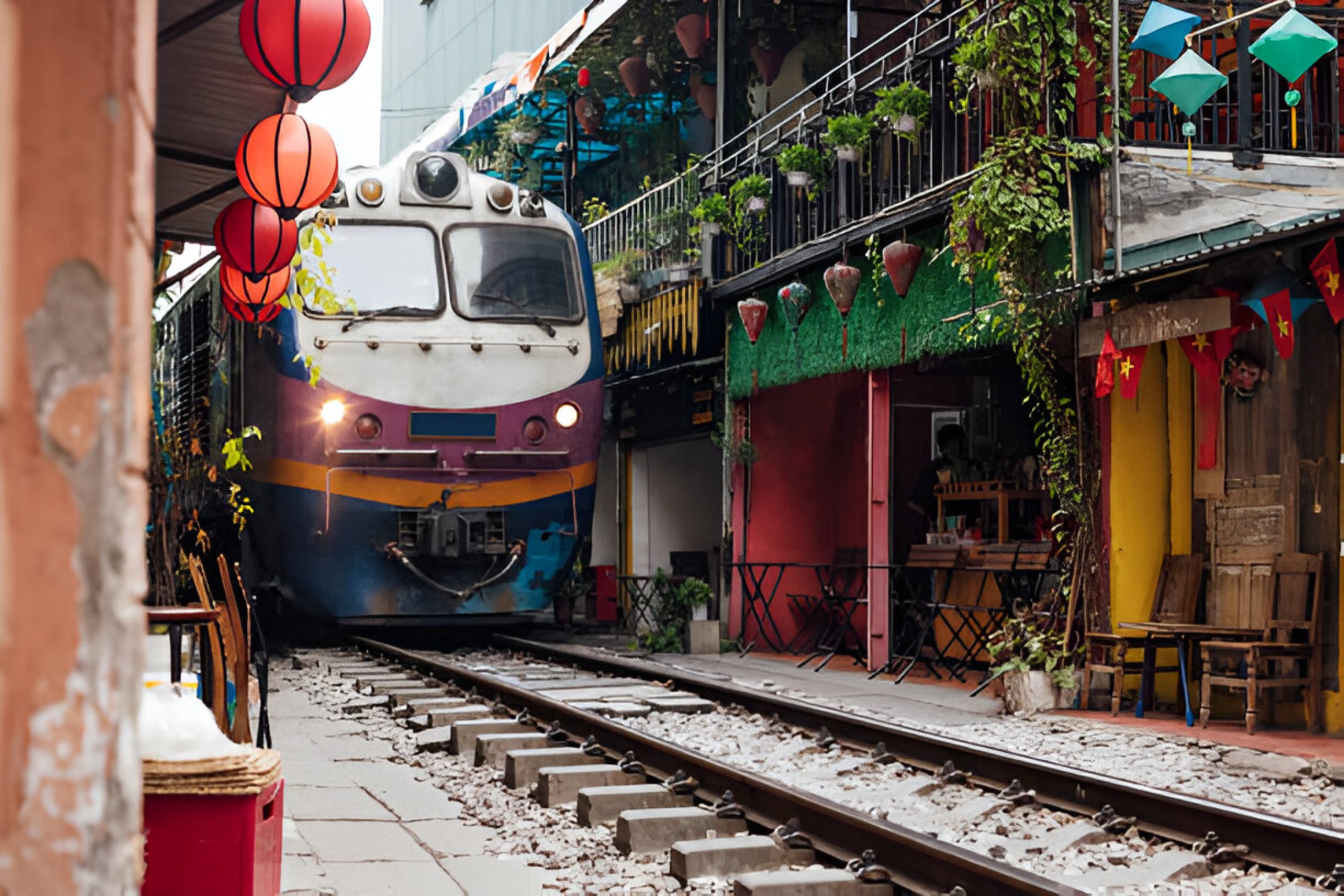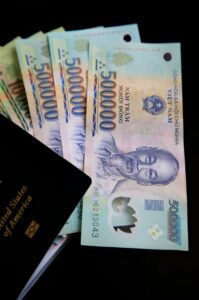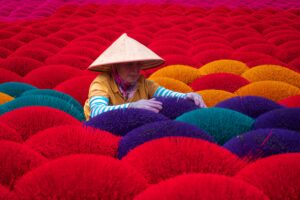Things not to do when in Vietnam
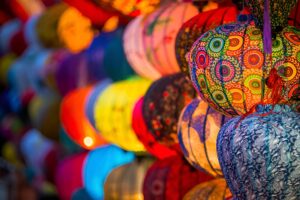
Do’s and Don’ts When Traveling in Vietnam
Traveling in Vietnam is a beautiful adventure filled with rich history, vibrant culture, and delicious food. But like any destination, there are cultural norms to respect and local practices to follow. Let me walk you through some of the essential dos and don’ts I’ve learned, which will help you have a smooth and enjoyable experience in this beautiful country.
Essential Do’s for Traveling in Vietnam
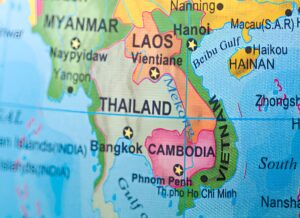
Vietnam is an exciting blend of ancient traditions, bustling cities, and mouth-watering street food. Whether you’re strolling through Hanoi’s Old Quarter or cruising the Mekong Delta, following local customs will enrich your travel experience and help you connect more deeply with the culture. Let’s dive into the essential do’s and don’ts to ensure your trip is smooth, enjoyable, and respectful. I recommend booking your flight in advance. This will save some money, and you will get some good deals. I used Skyscanner for my Flight booking.
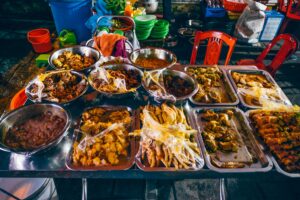
Do try the street food, it’s delicious and affordable
Vietnam is a street food lover’s paradise. Whether you’re strolling through Hanoi’s bustling streets or exploring the alleys of Ho Chi Minh City, street food is everywhere, and it’s a huge part of the local culture. Along with Pho and Banh Mi, remember to try other regional delicacies like Banh Xeo (crispy Vietnamese pancakes) and Che (a sweet dessert soup). Street food stalls are usually open from early morning until late at night, making them a convenient option at any time of the day. Not only is the food affordable, but the lively atmosphere around these stalls will give you a genuine feel for daily Vietnamese life.
Tip for safety: Stick to stalls that are busy with locals, as high turnover ensures the food is fresh. Also, pay attention to hygiene and make sure your food is cooked in front of you to minimize any risks.
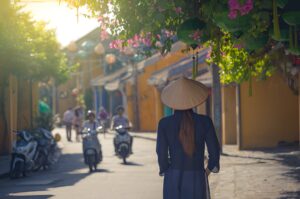
Do dress modestly when visiting temples and other religious sites
Temples and pagodas are not just tourist attractions; they are sacred spaces that hold significant spiritual meaning for the Vietnamese people. While Vietnam is a reasonably laid-back country in terms of dress, modest clothing is required when visiting these religious sites. For women, wearing a long skirt or pants and a top that covers the shoulders is advisable. Men should also avoid shorts and sleeveless tops. Bringing a light scarf or shawl is not only practical for covering up, but it can also double as protection against the sun when walking outdoors.
Local insight: Some temples may provide cover-ups at the entrance. If your attire is not deemed appropriate, you can get them. But it’s always better to come prepared. Dressing respectfully will also earn you smiles from the locals, making your visit feel more enriching.

Do take your shoes off when entering someone’s home or a temple
Vietnamese culture places a high value on cleanliness and respect, especially in private homes and places of worship. Always take your shoes off before entering a Vietnamese home or a temple. This practice shows that you respect the sanctity of the space and helps maintain cleanliness. Many homes will provide slippers for indoor use. Especially in rural areas. Temples, on the other hand, may require you to walk barefoot, so it’s a good idea to carry socks if you’re uncomfortable walking without shoes.
Extra tip: This rule doesn’t just apply to homes and temples — some shops, spas, and even traditional restaurants may expect you to remove your shoes. Look out for piles of shoes at the entrance, or ask the staff if you’re unsure.
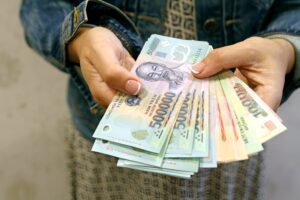
Do carry small bills of Vietnamese Dong for easy transactions
Carrying small bills is a practical tip that will save you a lot of hassle when traveling through Vietnam. While larger stores and hotels might accept credit cards, many local shops, markets, and taxis are cash-based, and they often won’t have change for large denominations like 500,000 VND (approximately $20). Keeping small notes, such as 10,000 or 20,000 VND, is crucial for quick, smooth transactions. You’ll find that most everyday items like street food, water, or small souvenirs will cost less than 100,000 VND.
Currency tip: Always check your bills carefully when paying, as the zeros can be confusing at first. It’s easy to mix up a 10,000 VND note with a 100,000 VND note because of the similar colors. I did this myself, so stay aware of this. Additionally, keep in mind that ATMs are widely available in cities, but if you’re heading to rural areas, withdraw enough cash in advance.
Vietnamese Banknotes Guide:
The banknotes in circulation are made of polymer, which makes them durable and resistant to damage.
Current Banknotes:
- 500 VND: Rarely used in daily transactions due to its low value.
- 1,000 VND: A small denomination, rarely used, but still legal tender.
- 2,000 VND: Common for small transactions like street food or local shops.
- 5,000 VND: Used for low-value purchases.
- 10,000 VND: Often used in local transactions.
- 20,000 VND: A popular denomination suitable for street food and small purchases.
- 50,000 VND: Used widely, especially in medium-value transactions.
- 100,000 VND: Common for daily expenses like groceries and dining.
- 200,000 VND: Used for larger purchases and in more upscale settings.
- 500,000 VND: The largest denomination and most frequently used for larger payments like accommodation or electronics.
Note: 20,000 VND and 500,000 VND notes are similar in color, which can sometimes confuse.
Historical Banknotes (No Longer Issued):
- 10 VND, 20 VND, 50 VND, 100 VND, and 200 VND: These low denominations have largely been phased out.
- 50,000 VND (old design): The design of the 50,000 VND bill was updated to the polymer version.
Vietnamese Coins:
While coins were introduced in 2003, they are rarely seen in circulation today due to their impracticality compared to polymer notes.
Previously Circulated Coins:
- 200 VND: Copper-colored coin, rarely seen.
- 500 VND: Small silver-colored coin.
- 1,000 VND: Larger, gold-colored coin.
- 2,000 VND: Gold-colored coin.
- 5,000 VND: The highest-value coin, silver-colored.
Current Use of Coins:
While these coins remain legal tender, they are not widely used in everyday transactions. Most people prefer to use banknotes due to the ease of handling.
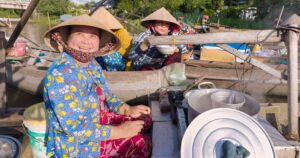
Do learn a few basic phrases in Vietnamese, it shows respect for the culture
While many people in Vietnam’s main cities speak some English, especially those in the tourism industry, learning a few basic Vietnamese phrases can go a long way in showing your respect for the local culture. Words like “Xin chào“ (Hello), “Cảm ơn“ (Thank you), and “Xin lỗi“ (Sorry) are simple but appreciated. Vietnamese people often smile when tourists make an effort, even if your pronunciation isn’t perfect. It also helps break down barriers and create friendlier interactions with locals.
Language tip: Vietnamese is a tonal language, so the meaning of a word can change depending on your tone. While this might make learning the language seem intimidating, focus on a few basic phrases, and you’ll be fine. Language learning apps like Duolingo can be handy for quick lessons on the go.
- Hello: Xin chào (seen chow)
- Thank you: Cảm ơn (gahm urn)
- Yes: Vâng (vuhng) or Dạ (yah)
- No: Không (khom)
- Excuse me / Sorry: Xin lỗi (seen loy)
- How much?: Bao nhiêu? (bow nyew)
- Goodbye: Tạm biệt (tahm bee-et)
- Please: Làm ơn (lahm urn)
- I don’t understand: Tôi không hiểu (toy khom hee-u)
- Water: Nước (nook)
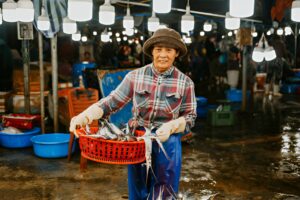
Do be respectful towards locals and their customs
Vietnamese culture is deeply rooted in tradition and respect, and being mindful of this will greatly enhance your experience. Greeting people with a slight nod or bow is a polite way to acknowledge their presence. When interacting with locals, avoid touching people, especially on the head, as this is considered disrespectful. Another key custom is not raising your voice or showing frustration in public. Vietnamese people generally prefer to resolve issues calmly and quietly, so maintaining a polite demeanor is essential. I learn this the hard way. I messed up in many ways, but my host corrected me.
Cultural tip: Avoid public displays of affection, especially in rural areas. While holding hands is generally acceptable, kissing or hugging in public can be seen as inappropriate. When visiting someone’s home, bringing a small gift like fruit or sweets is also a thoughtful gesture.
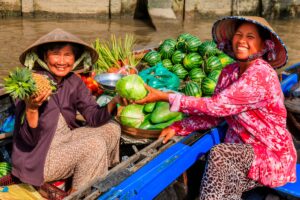
Do visit the local markets, they are a great way to experience the culture
Vietnamese markets are bustling hubs of activity and offer an immersive experience of local life. From the vibrant stalls selling fresh produce and street food to the vendors hawking handmade crafts and souvenirs, markets are the perfect place to see how everyday life unfolds in Vietnam. Some of the most famous markets include Ben Thanh Market in Ho Chi Minh City and Dong Xuan Market in Hanoi. Don’t be afraid to haggle — bargaining is expected and part of the fun! Just make sure to keep it friendly and light-hearted.
Pro tip: Early mornings are the best time to visit for the freshest produce and the most authentic atmosphere, as many locals do their shopping early. Be mindful of personal space, as markets can get quite crowded, and always keep an eye on your belongings.
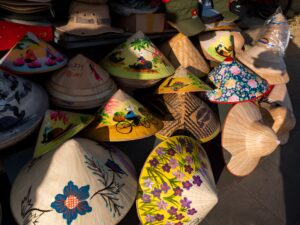
Do use sunscreen and a hat to protect yourself from the sun
Vietnam’s tropical climate means strong sunlight year-round. Hence, protecting yourself from the sun is essential, especially if you plan on spending long hours outdoors. Whether you’re exploring historical sites or relaxing on the beaches of Phu Quoc or Nha Trang, be sure to apply a high-SPF sunscreen regularly and wear a hat to shield your face. Sunglasses are also a great addition to protect your eyes from the glare.
Extra tip: If you have sensitive skin, lightweight, long-sleeved clothing made from breathable fabrics like cotton can help protect you from both the sun and mosquitoes without causing you to overheat.
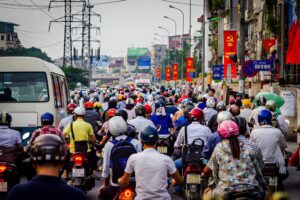
Do be prepared for the traffic, especially in cities like Hanoi and Ho Chi Minh City
The traffic in Vietnam, particularly in large cities like Hanoi and Ho Chi Minh City, can seem chaotic to first-time visitors. Scooters are the dominant form of transportation, and they fill the streets with what may look like a non-stop flow of vehicles. Crossing the street might feel daunting at first, but here’s the trick: move at a steady pace and let the traffic flow around you. Don’t stop suddenly or run — just walk slowly and confidently, and the drivers will maneuver around you. I know this sounds weird, but this is the way of Vietnam.
Traffic tip: If you’re still nervous, try crossing with a group of locals. You can also use ride-hailing apps like Grab to get around more efficiently, which is a safer alternative to random motorbike taxis.
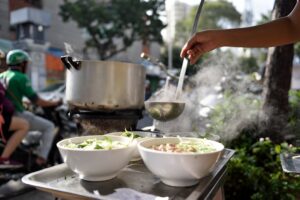
Do negotiate prices when shopping at markets
Negotiating is part of the shopping experience in Vietnam, especially at local markets. While it might feel awkward at first, haggling is a cultural norm and can even be fun when done with a friendly attitude. Most vendors expect some negotiation, but it’s essential to keep the process polite and respectful. Start by offering about 30-50% of the asking price and work your way to a fair deal.
Haggling tip: Always smile and stay calm, even if the negotiation feels tough. If a vendor doesn’t agree to your price, don’t be afraid to walk away — they might call you back and agree to your offer. But remember, haggling should be done in good spirits; the goal isn’t to get the lowest price but to come to a mutually agreeable deal.
Things not to do when in Vietnam
Now that we’ve covered the do’s, let’s move on to the don’ts — knowing what to avoid is just as important to ensure a respectful and smooth trip in Vietnam.
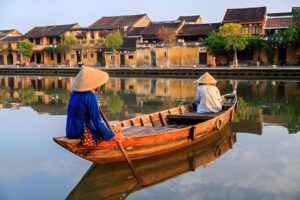
Don’t touch someone’s head, it is considered disrespectful in Vietnam
In Vietnamese culture (as well as in many other Asian cultures), the head is seen as the most sacred part of the body. Even when interacting with children, avoid touching their heads as it can be perceived as disrespectful. This cultural belief is rooted in Buddhism, which teaches that the head is the seat of a person’s soul and spirit. As a general rule, avoid touching anyone’s head unless you’re sure it’s acceptable in that particular context.
Cultural sensitivity tip: If you’re unsure about what’s culturally appropriate, it’s always best to observe how locals interact with each other before jumping in. This is a good practice, not just for physical gestures but for behavior in general.
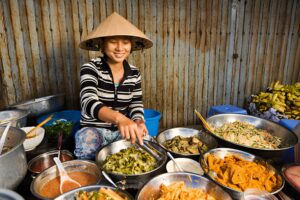
Don’t wear revealing clothing, it is not appropriate in the culture
Vietnamese culture places a high value on modesty, especially in rural areas and when visiting temples or religious sites. Revealing clothing, such as short shorts, low-cut tops, or skimpy swimwear, may attract unwanted attention and is considered disrespectful in certain places. When visiting sacred sites, always cover your shoulders and knees. In more relaxed, urban settings like Ho Chi Minh City or Hanoi, the dress code is a bit more lenient, but it’s still a good idea to err on the side of modesty.
Travel tip: While swimwear is acceptable at the beach or poolside, it’s best to cover up when you’re off the beach, even at beachside restaurants. Keeping a light scarf or wrap in your bag is a handy way to stay covered in public areas.

Don’t raise your voice or show anger in public, it is considered impolite
Public outbursts, loud arguments, or raising your voice are seen as losing face in Vietnam, which can be a significant cultural faux pas. If you find yourself in a frustrating situation — whether negotiating a price, dealing with delays, or encountering a misunderstanding — it’s essential to remain calm and composed. Losing your temper in public is seen as disrespectful, and it’s far better to address issues with patience and a smile.
Conflict resolution tip: If you’re ever in a situation where you need to express dissatisfaction, doing so privately and respectfully is the best approach. Most locals will appreciate your effort to handle matters calmly, and it’s often more effective.
Dealing with Travel Frustrations in Vietnam:
- Language Barriers: Learn basic Vietnamese phrases or use a translation app. Be patient and polite if communication issues arise.
- Delays: Whether it’s transportation or service, delays can happen. Carry snacks, stay hydrated, and be flexible with your schedule.
- Traffic: Traffic in cities like Hanoi and Ho Chi Minh can be overwhelming. Use ride-hailing apps like Grab to avoid confusion and ensure safer transport.
- Misunderstandings: Stay calm and friendly. A smile and respectful attitude go a long way in resolving issues quickly.

Don’t drink tap water, always drink bottled water
In Vietnam, it’s essential to avoid drinking tap water, as it’s generally not safe for tourists. Always stick to bottled water, which is readily available in convenience stores, hotels, and restaurants. Make sure the seal on the bottle is intact before drinking. When ordering beverages with ice, be cautious as well, especially in rural areas. In more developed areas like Hanoi and Ho Chi Minh City, ice is often made with purified water, but it’s still wise to double-check with the staff. This is another lesson I learned from getting stomach upset.
Water safety tip: Use bottled water even for brushing your teeth, and avoid consuming fruits or vegetables that may have been washed in tap water unless you’re confident they’re from a reliable source.
Key tips could include:
- Stick to bottled or boiled water, and check that the seal is intact.
- Avoid ice made from tap water in areas where water quality may be questionable.
- Use water purification tablets or portable filters if needed.
I also suggest booking your hotel in advance. You can check all the reviews and get an idea of the quality of the hotel. Some hotels provide filtered water in-house, so you don’t have to worry about the water. I booked my hotel in Advance through Skyscanner and ended up with a nice hotel room.
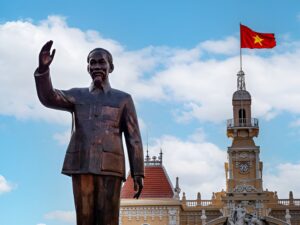
Don’t disrespect the national flag or the country’s leaders
In Vietnam, the national flag and its leaders are symbols of great pride and respect. Disrespecting them in any form—whether through words, actions, or gestures—can lead to serious repercussions. This includes mishandling the flag, making derogatory remarks, or discussing political matters in a negative light. It’s best to steer clear of any jokes or offhand comments about politics, especially concerning the Vietnam War or current government leaders.
Cultural tip: Vietnamese people are generally very proud of their country and history, so it’s important to be mindful of this when engaging in conversation. When in doubt, keep the conversation focused on the positive aspects of your experience in Vietnam.
- Avoid politics, religion, and war history unless locals bring them up first.
- Be respectful and listen more than you speak when these topics arise.
- Stick to neutral, positive topics like food, culture, or local experiences.
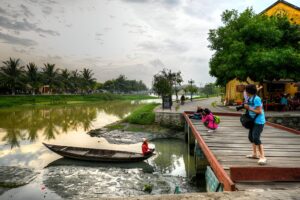
Don’t take photos of people without their permission
While it can be tempting to snap photos of the beautiful locals in their traditional attire or at markets, it’s important to ask for permission first. Many people in Vietnam value their privacy, and photographing them without consent can be seen as intrusive or disrespectful. This is especially true in rural areas and at religious sites. If you’re photographing a public event or festival, it’s usually fine to take pictures, but for personal or close-up shots, always ask first.
Photography tip: Learning the Vietnamese phrase, “Tôi có thể chụp ảnh không?” (Can I take your picture?), is a polite way to ask for permission. Most locals will appreciate the courtesy, and some might even be happy to pose for you!
- Acceptable:
- Public areas, tourist attractions, markets, and natural landscapes are fine.
- Street photography is common, but it’s polite to ask for permission before photographing locals, especially in rural areas.
- Off-limits:
- Military areas, government buildings, and certain infrastructure like bridges and ports.
- Some religious sites (temples, pagodas) may restrict photography during prayer or ceremonies. Always check for signs and ask for permission.

Don’t litter, the country is struggling with waste management
Vietnam is facing significant challenges when it comes to waste management, particularly in rural and coastal areas. Littering, whether in cities or natural landscapes, is frowned upon. As a responsible traveler, make sure to dispose of trash properly, and if you’re unable to find a bin, carry your trash with you until you can. In some areas, like beaches or national parks, locals and tourists alike are encouraged to pick up litter to help keep these beautiful places clean.
Eco-friendly tip: Consider carrying a reusable water bottle, bamboo utensils, and reusable shopping bags to minimize single-use plastics. These small steps can make a big difference, especially in countries like Vietnam where waste management infrastructure is still developing.
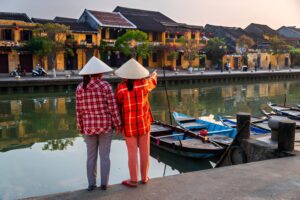
Don’t use your feet to point at something or someone
In Vietnamese culture, the feet are considered the lowest and dirtiest part of the body, so using them to point at objects or, worse, at people, is seen as highly disrespectful. When sitting, avoid showing the soles of your feet, especially when facing someone. If you need to point to something, always use your hand rather than your foot.
Cultural sensitivity tip: If you’re sitting on the floor, try to tuck your feet underneath you or sit cross-legged to avoid pointing your feet at others. This gesture shows a level of mindfulness and respect for local customs.

Don’t bring up the Vietnam War or politics in general
The Vietnam War (referred to as the “American War” in Vietnam) is still a sensitive subject for many locals. It’s best to avoid discussing it altogether unless a local brings it up first, and even then, approach the topic with care and respect. Similarly, discussing political topics, particularly the government or its leaders, can be seen as inappropriate or even dangerous in certain contexts.
Conversation tip: Stick to light-hearted topics like food, culture, and travel experiences. Vietnamese people are incredibly proud of their heritage, so asking about local traditions or customs can lead to fascinating conversations.
- Food: Asking about local dishes, markets, or recipes.
- Culture: Festivals, traditions, or regional customs.
- Travel: Recommendations for places to visit in Vietnam or sharing your travel experiences.
- Family: Vietnamese people often enjoy talking about their families
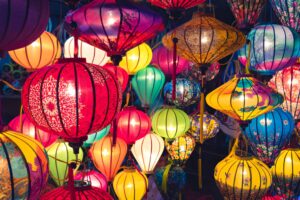
Don’t show too much affection in public
Public displays of affection (PDA) are not common in Vietnam, particularly in rural areas and more traditional settings. Holding hands is usually fine, but kissing or hugging in public can be seen as inappropriate. If you’re traveling as a couple, try to keep affectionate gestures private out of respect for the local culture.
Travel tip: In cities like Hanoi and Ho Chi Minh City, the norms around PDA are a bit more relaxed, but even in these areas, it’s best to avoid overly intimate gestures in public spaces. A general rule is to be mindful of your surroundings and adjust accordingly.
Additional Travel Tips for Vietnam
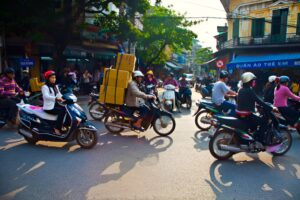
Be prepared for chaotic traffic
As I mentioned earlier, traffic in Vietnam can be overwhelming, especially in cities like Hanoi and Ho Chi Minh City. Motorbikes rule the streets, and there seems to be a constant flow of vehicles at all hours. The key to crossing the street safely is to move slowly and steadily — the traffic will adjust to you. Hesitating or rushing could cause confusion, so walk at a regular pace and the drivers will work around you.
Extra tip: Consider using Grab (Southeast Asia’s version of Uber) if you’re uncomfortable navigating the traffic alone. It’s affordable and safer than hailing random motorbikes on the street.
- Taxis: Use reputable companies like Mai Linh or Vinasun, or rely on ride-hailing apps like Grab to avoid scams. Always ensure the meter is running or agree on a price before starting the trip.
- Motorbike Taxis (Xe Ôm): Widely available, but safety can vary. Use GrabBike for a more secure option. Always wear a helmet.
- Buses: Cheap and convenient, especially for long-distance travel, but schedules can be inconsistent. For city buses, research routes in advance as signs are usually in Vietnamese.
- Trains: For longer journeys, trains are a safe and comfortable option, especially on popular routes like Hanoi to Ho Chi Minh City.
- Walking: Safe in most areas, but be cautious when crossing streets, especially in cities like Hanoi or Ho Chi Minh City, where traffic can be chaotic.
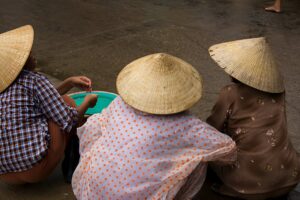
Try to engage with local customs
Vietnamese people are incredibly welcoming, and they appreciate when tourists show respect for their traditions. This can be as simple as learning a few phrases in Vietnamese, dressing modestly at religious sites, or offering a small bow when greeting someone older. Engaging with locals by asking about their culture, customs, or food is often met with enthusiasm.
Cultural engagement tip: If invited to someone’s home, bring a small gift like fruit or flowers as a token of gratitude. It’s also polite to wait for the host to invite you to sit down at the dining table before eating.
Should we expand this section with a list of the most important cultural customs to observe?
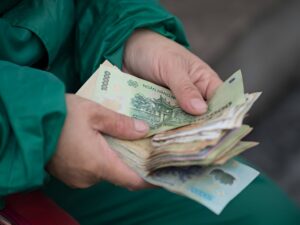
Always carry small amounts of cash
While many places in bigger cities now accept credit cards, cash is still king in Vietnam, especially in smaller shops, markets, or when dealing with street vendors. ATMs are common, but it’s a good idea to have small notes ready for easy transactions. You’ll find it much easier to navigate the markets, pay for taxis, or buy street food if you have cash on hand.
Travel tip: Keep larger bills for bigger purchases and break them down when possible at restaurants or shops that are likely to give you change. Also, consider keeping some of your cash hidden in different parts of your bag or clothing for safety.
- Use Small Bills: Carry smaller denominations for daily expenses to avoid showing large amounts of cash when paying in public.
- Split Your Cash: Keep your cash in multiple places (wallet, hidden money belt, hotel safe) so you’re not vulnerable if your wallet is lost or stolen.
- Avoid Flashing Money: When making payments, only take out the amount you need, especially in crowded areas.
- ATMs: Use ATMs in secure locations like inside banks or shopping malls, and avoid those in isolated or poorly lit areas.
- Credit Cards: Use credit cards only in reputable hotels, restaurants, or large stores, as card fraud can occur in smaller establishments.
FAQs
What are some local etiquettes I should follow in Vietnam?
Respect is key in Vietnam. Always greet elders first, take your shoes off when entering a home, and avoid touching anyone’s head. When giving or receiving something, use both hands. Public displays of anger or frustration should also be avoided, as maintaining a calm demeanor is important in Vietnamese culture.
Is it safe to eat street food in Vietnam?
Absolutely! Street food in Vietnam is a must-try, and it’s generally safe if you follow a few precautions. Choose busy stalls with a high turnover, as this usually means the food is fresh. Stick to dishes that are cooked in front of you or freshly made, and avoid ice or raw vegetables if you’re in areas with questionable water quality.
What should I avoid discussing with locals in Vietnam?
Sensitive topics like the Vietnam War, current political issues, or criticisms of the government should be avoided unless a local brings them up first. If they do, listen respectfully and avoid giving strong opinions. It’s best to stick to light-hearted topics like food, travel, or culture.
Are there specific behaviors that are considered disrespectful in Vietnamese culture?
Yes, a few things to avoid include pointing your feet at people or religious objects, touching someone’s head, raising your voice, and public displays of affection. Also, avoid littering and be mindful of your surroundings when visiting religious sites.
What to Avoid Wearing in Vietnam?
In general, Vietnam is a fairly relaxed country when it comes to dress, but there are some things to avoid:
- Revealing clothing: Especially in rural areas, temples, or when visiting religious sites. Avoid wearing skimpy clothing, such as low-cut tops, miniskirts, or clothing that exposes a lot of skin.
- Clothing with offensive symbols or language: Be mindful of wearing clothing with slogans or images that could be seen as offensive or disrespectful, particularly in terms of politics or religion.
Can I Wear Red in Vietnam?
Yes, you can wear red in Vietnam. In fact, red is considered a lucky color in Vietnamese culture, often associated with celebrations like Tet (Lunar New Year) or weddings. It’s perfectly fine and culturally acceptable to wear red clothing in daily life.
Do I Need to Wear a Bra in Vietnam?
There are no strict laws or cultural expectations around wearing a bra in Vietnam, especially in urban areas where fashion is more liberal. However, in more conservative or rural parts of the country, modesty is valued, so it’s generally recommended to wear a bra if you want to blend in and avoid drawing attention.
Can Ladies Wear Shorts in Vietnam?
Yes, ladies can wear shorts in Vietnam, especially in cities like Hanoi, Ho Chi Minh City, or beach destinations like Da Nang and Nha Trang. However, for visits to temples or religious sites, shorts are considered inappropriate. In these situations, you should wear longer pants or skirts that cover your knees.
What Are You Not Allowed to Bring to Vietnam?
There are several items that are restricted or prohibited from being brought into Vietnam:
- Drugs and narcotics: Vietnam has very strict drug laws, with severe penalties for possession or trafficking.
- Weapons and explosives.
- Pornographic material.
- Culturally sensitive material: Items that might be considered offensive to Vietnamese culture or politics.
- Endangered species products: Items made from endangered animals, such as ivory or certain kinds of animal skins, are prohibited.
What Foods Should I Avoid in Vietnam?
While Vietnamese food is delicious and diverse, there are some foods that you might want to avoid for health and safety reasons:
- Street food that looks unhygienic: Be cautious when eating street food if it appears to be poorly prepared or not fresh. Avoid stalls that leave food out in the open for long periods.
- Ice from questionable sources: In some areas, tap water isn’t safe to drink, so ice made from untreated water can pose a risk.
- Exotic meats: Some places offer exotic dishes made from animals like snakes or wild animals. If you’re unsure of the hygiene or ethical considerations, it’s best to avoid them.
Is Viagra Legal in Vietnam?
Yes, Viagra is legal in Vietnam. You can buy it from pharmacies, though it may be subject to local pharmaceutical regulations. It’s always a good idea to bring a prescription if you’re traveling with it, as this can help clarify any issues at customs or with local authorities.
Is It Safe to Wear Jewelry in Vietnam?
While it’s generally safe to wear jewelry in Vietnam, it’s best to avoid wearing expensive or flashy jewelry in crowded areas, especially in big cities like Ho Chi Minh City or Hanoi. Petty theft, like pickpocketing and snatch thefts, can occur, particularly in tourist-heavy areas, so being mindful of your valuables is wise.
What Should You Be Careful of in Vietnam?
- Traffic: Motorbikes dominate the streets, and crossing the road can be challenging. Be cautious and aware when navigating traffic.
- Petty theft: As mentioned, watch out for pickpockets, especially in crowded places or markets.
- Scams: Be aware of common tourist scams, such as inflated prices for taxis, tours, or services. Always negotiate prices or use reliable, licensed services.
- Health and hygiene: Pay attention to food hygiene, especially when eating at street stalls.
What is Considered Inappropriate in Vietnam?
- Public displays of affection (PDA): Kissing and hugging in public is generally frowned upon in Vietnamese culture.
- Disrespecting elders or people in authority: Vietnamese culture places a strong emphasis on respect for elders, so it’s important to be polite and courteous.
- Pointing with your finger or feet: Pointing at people or objects with your finger or feet is considered rude.
- Entering homes or temples with shoes on: Always remove your shoes when entering someone’s home or a religious site.
Talking loudly in religious or solemn places: Keep your voice down when visiting temples or pagodas.
Read my other blogs on ASIA.

